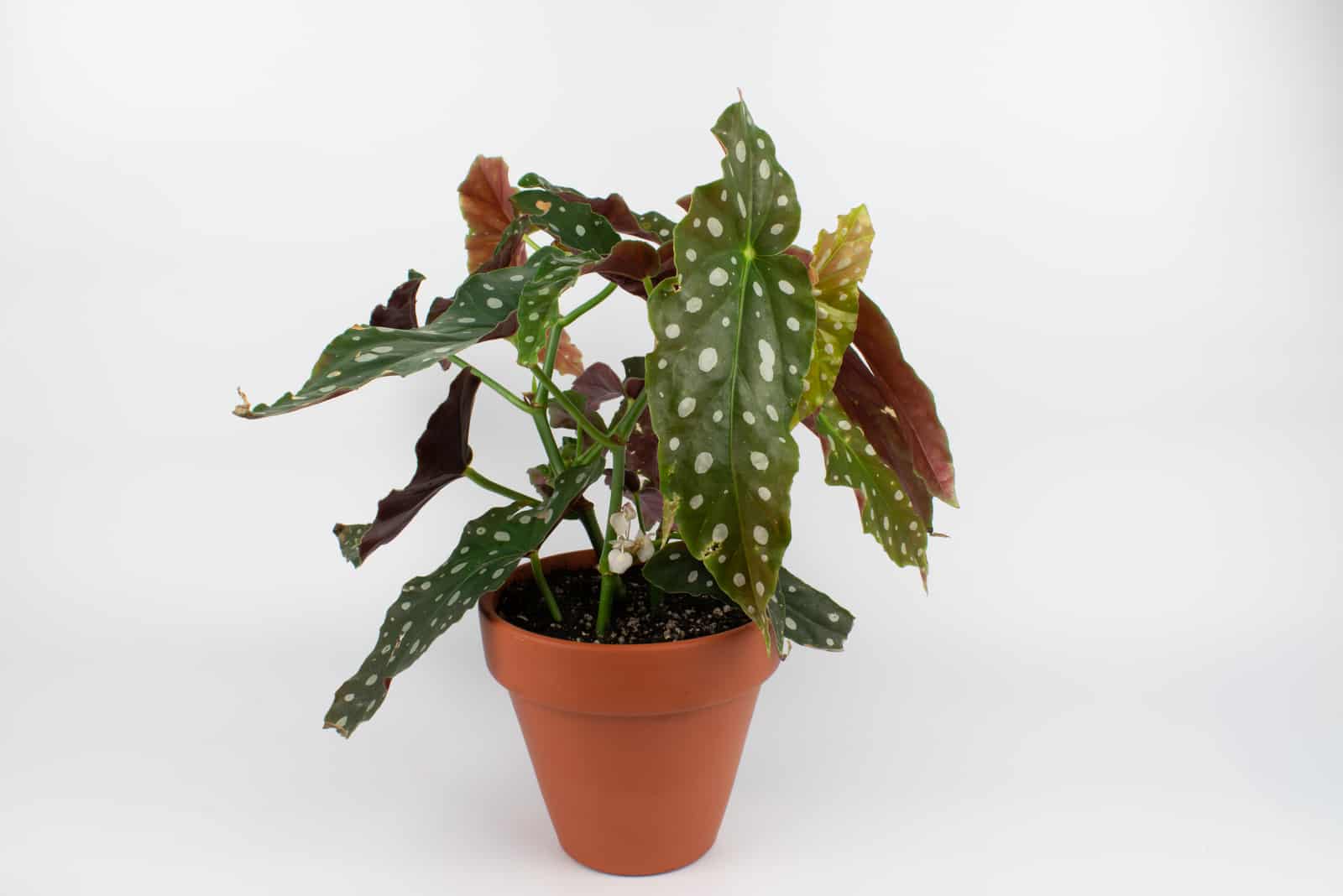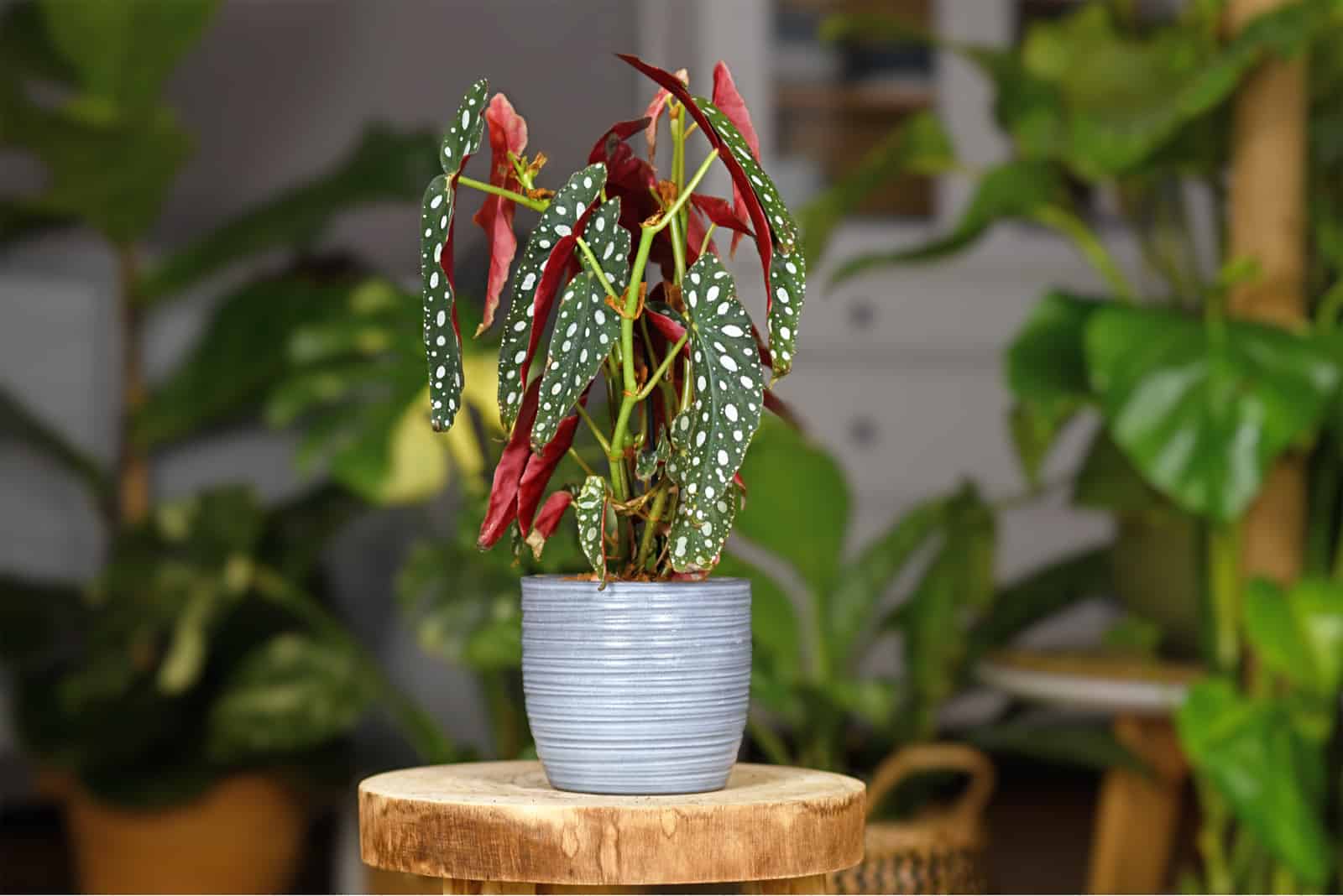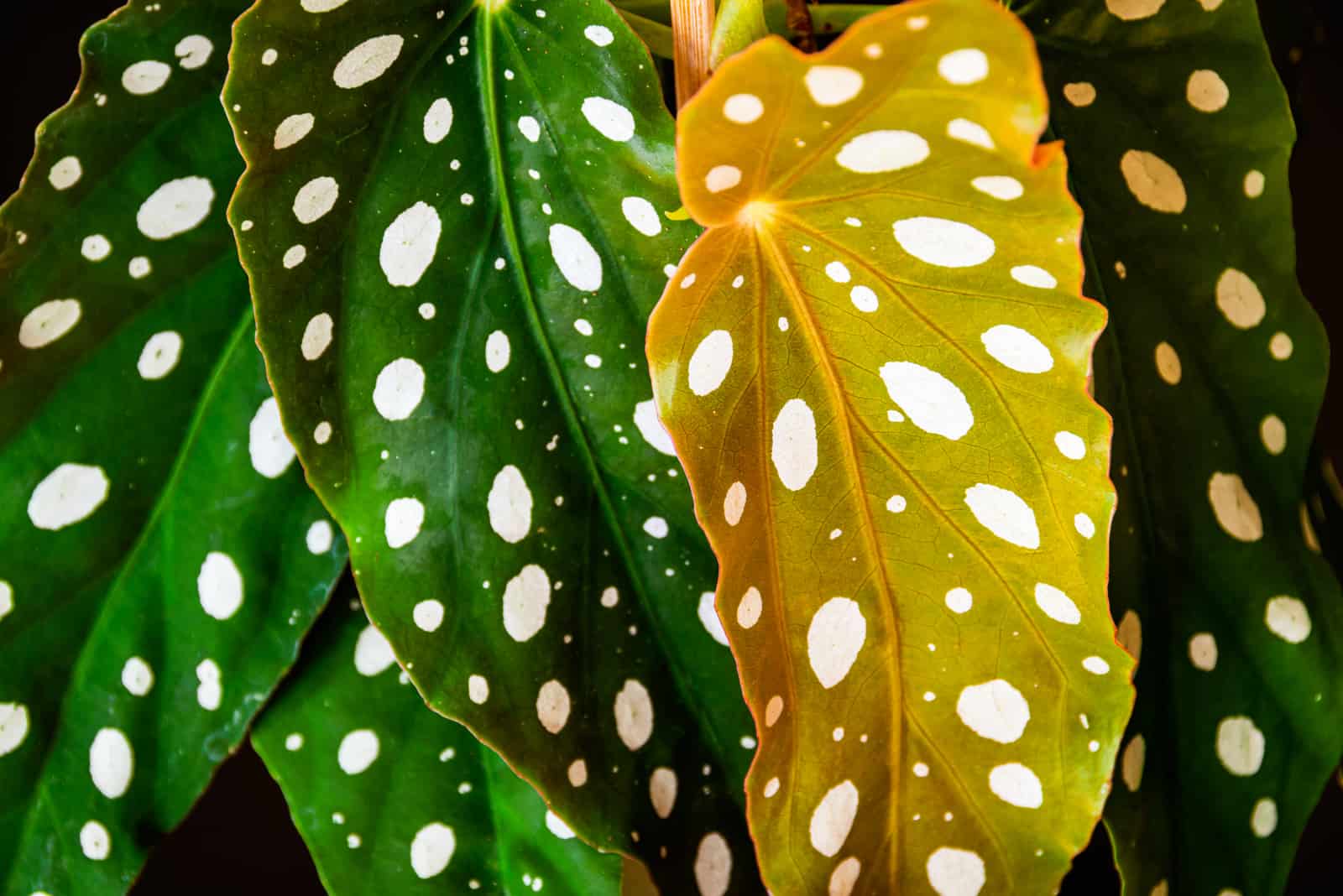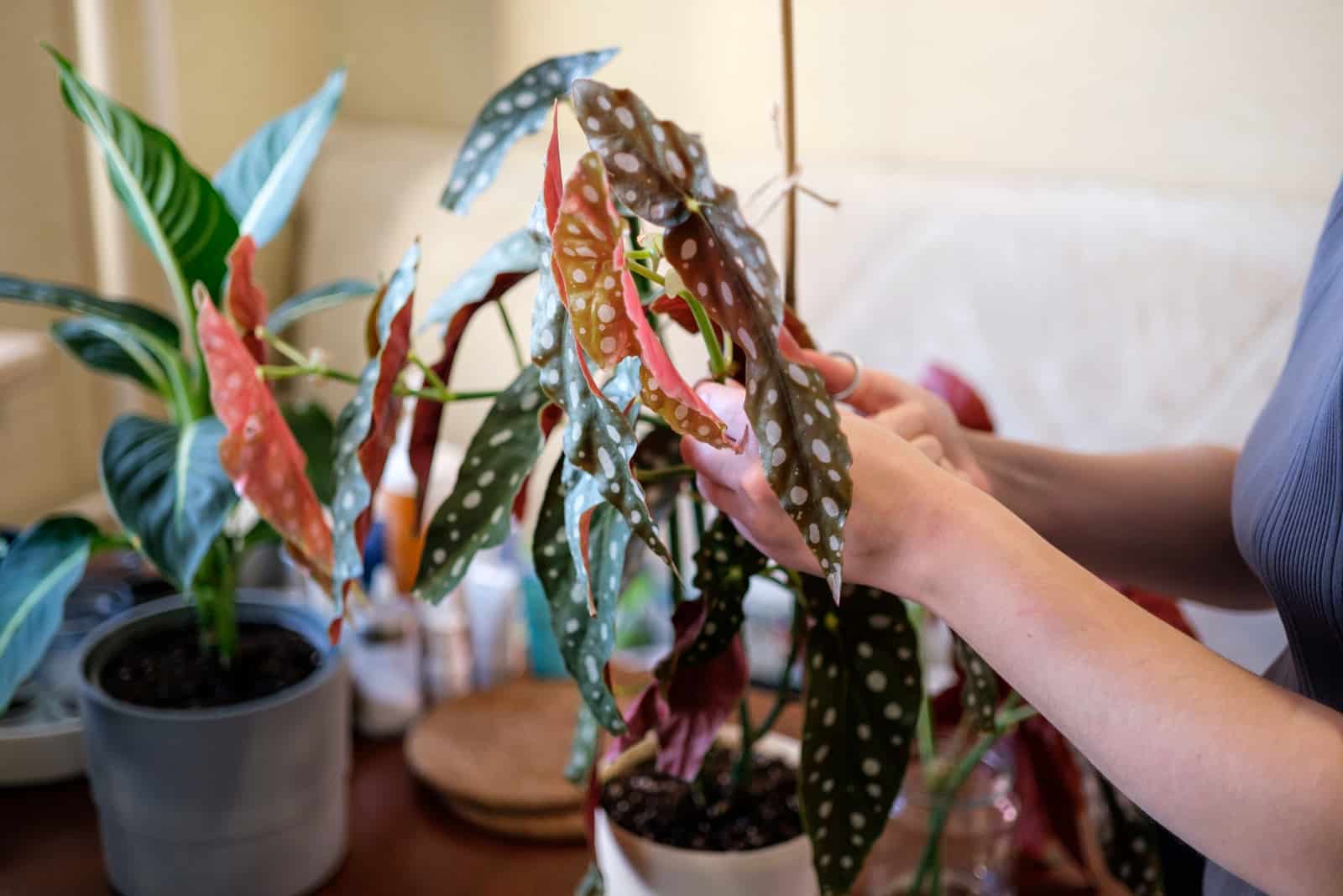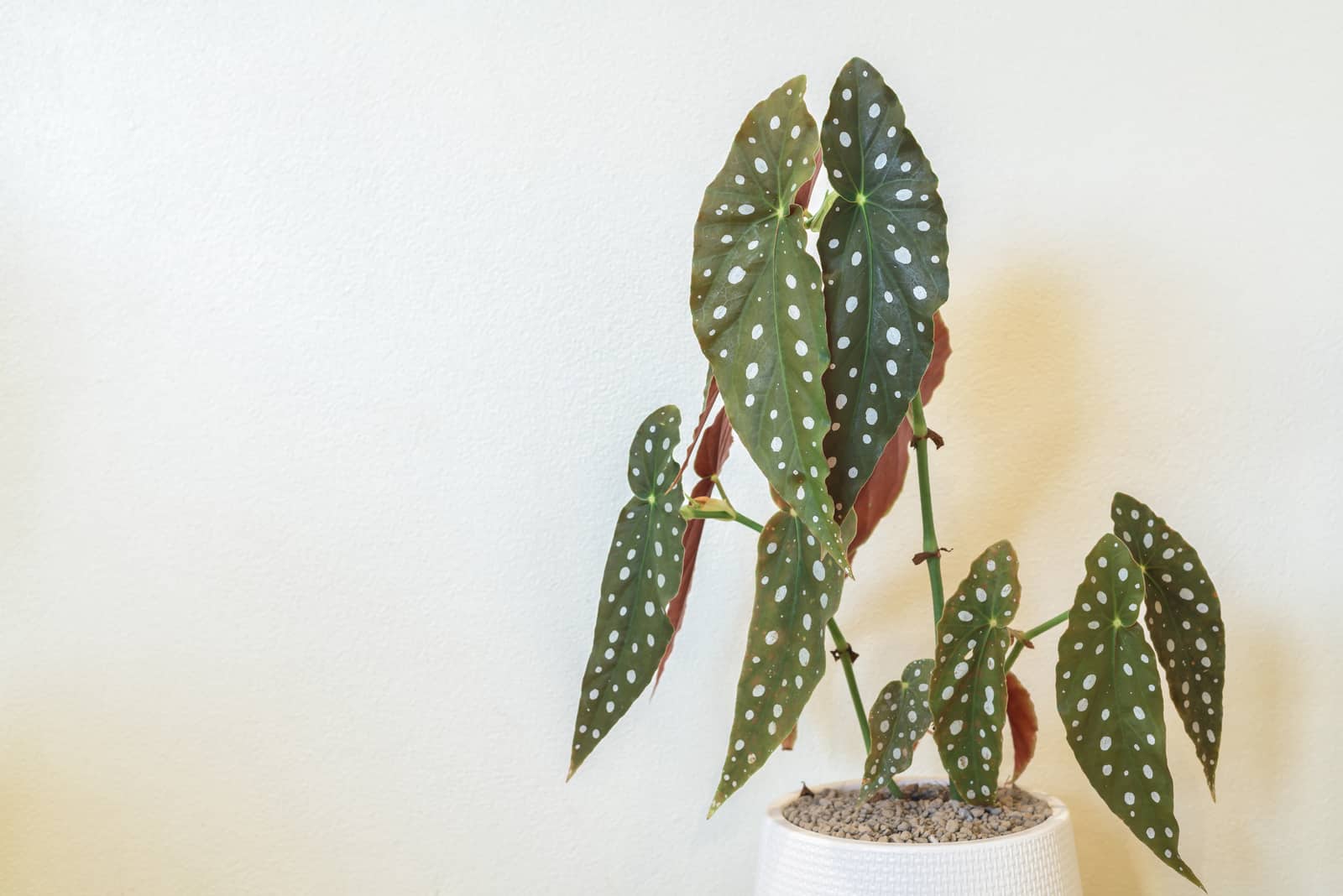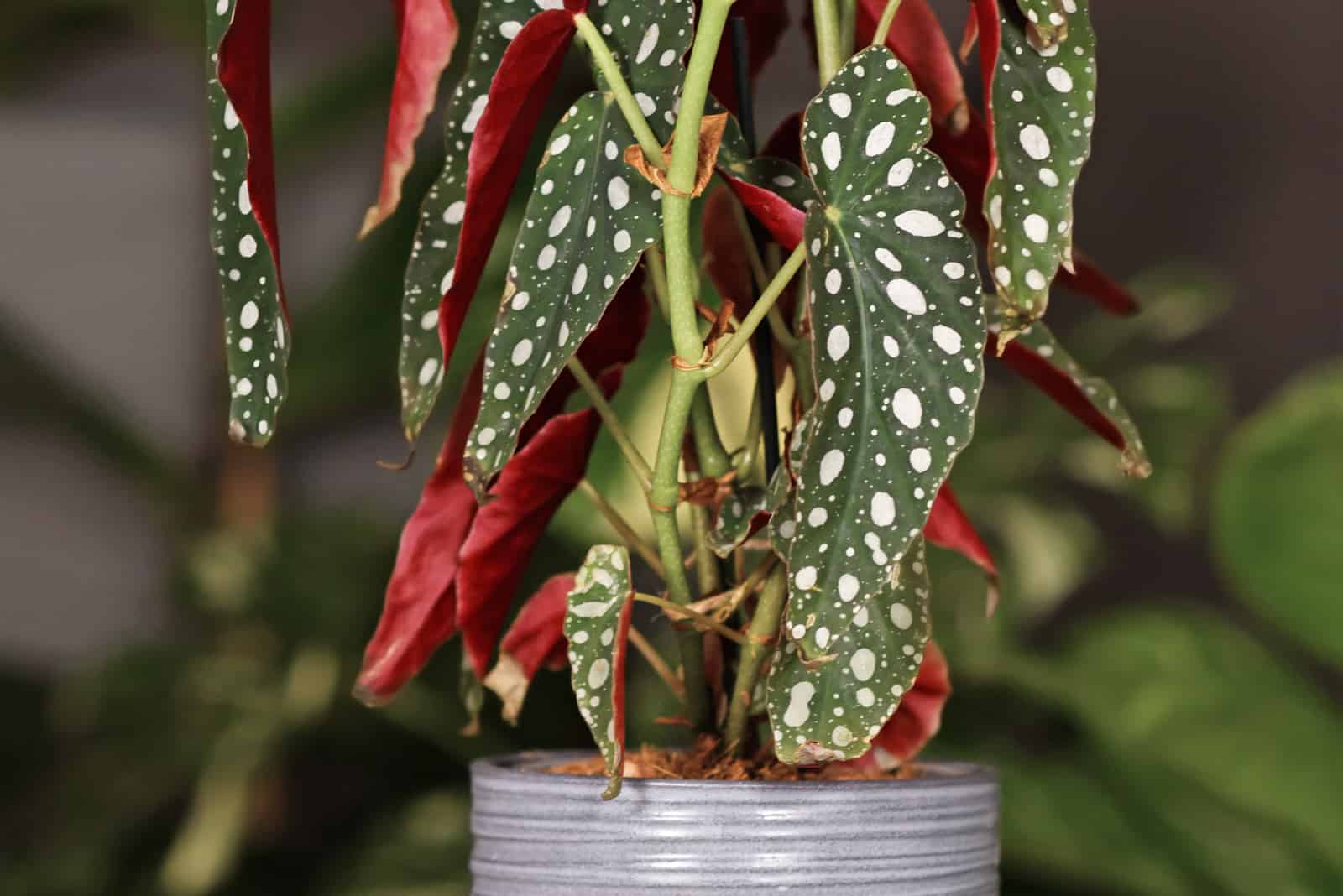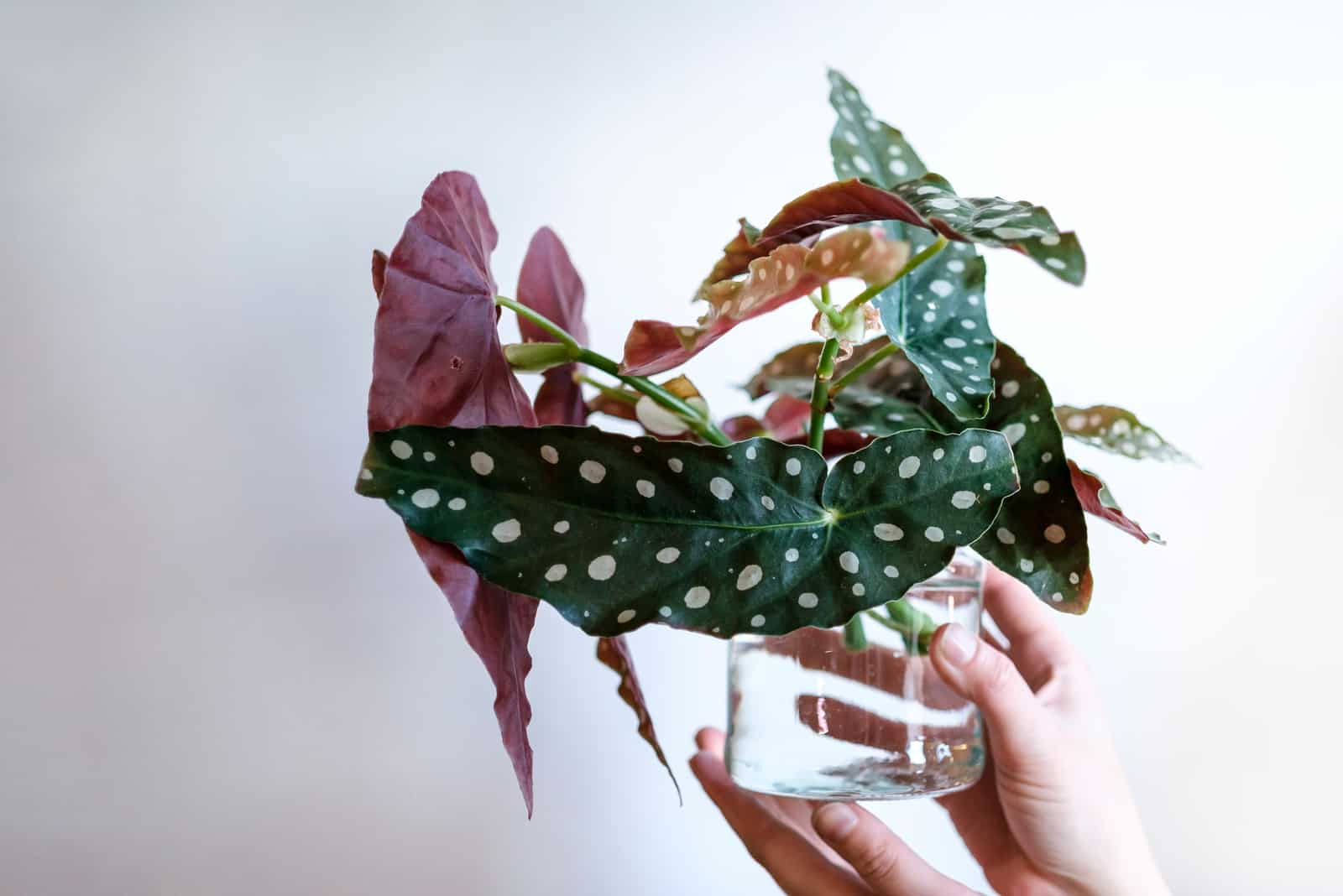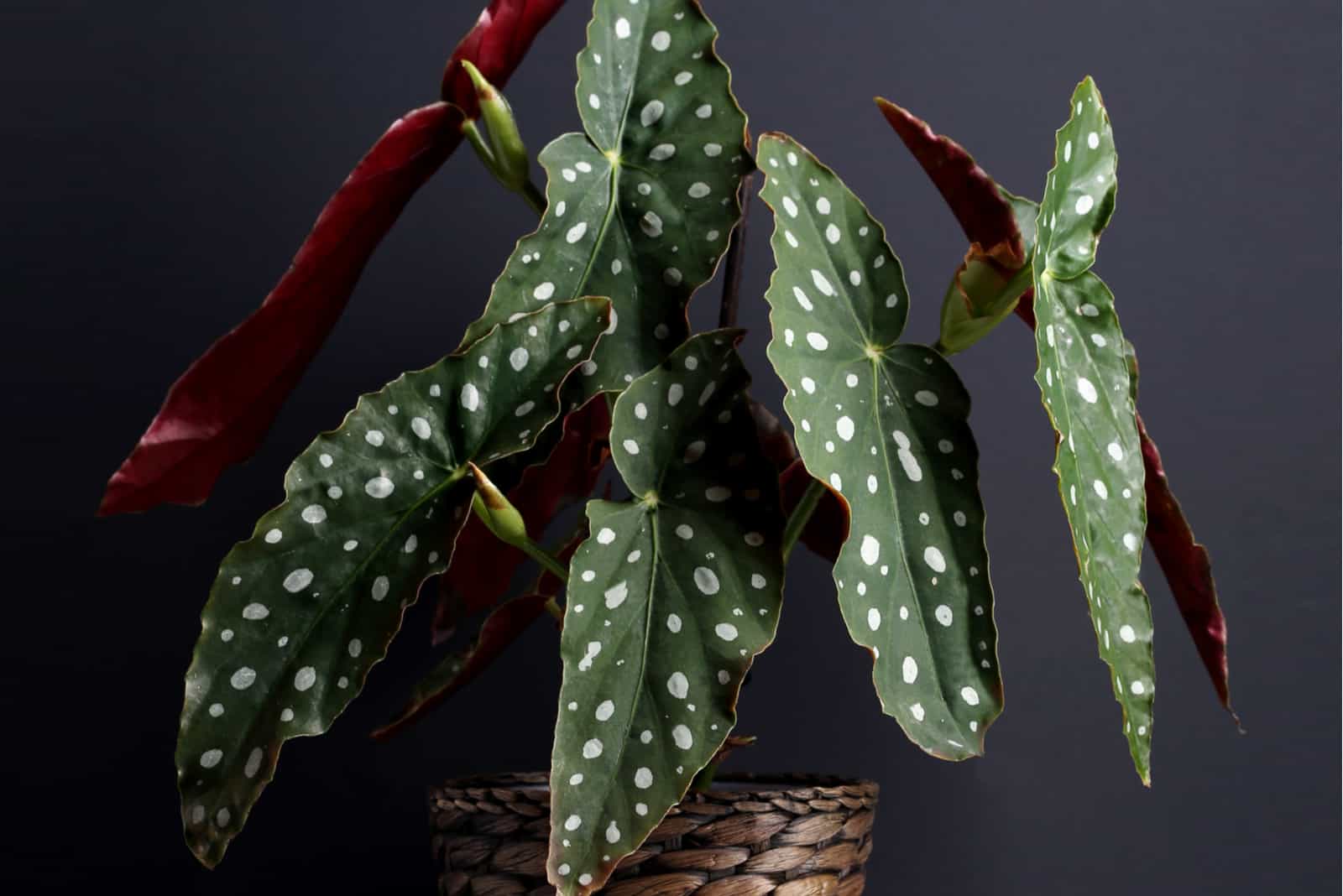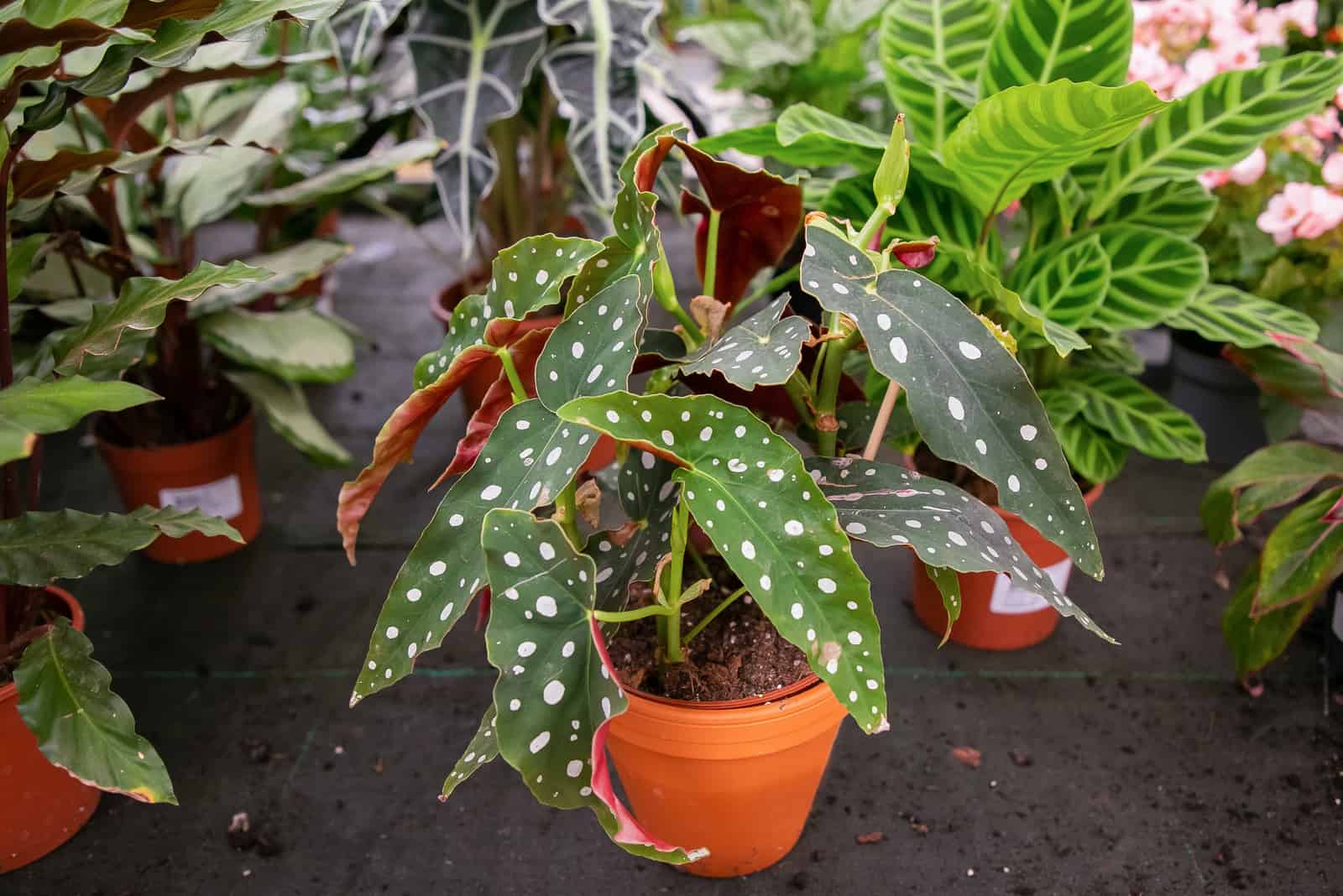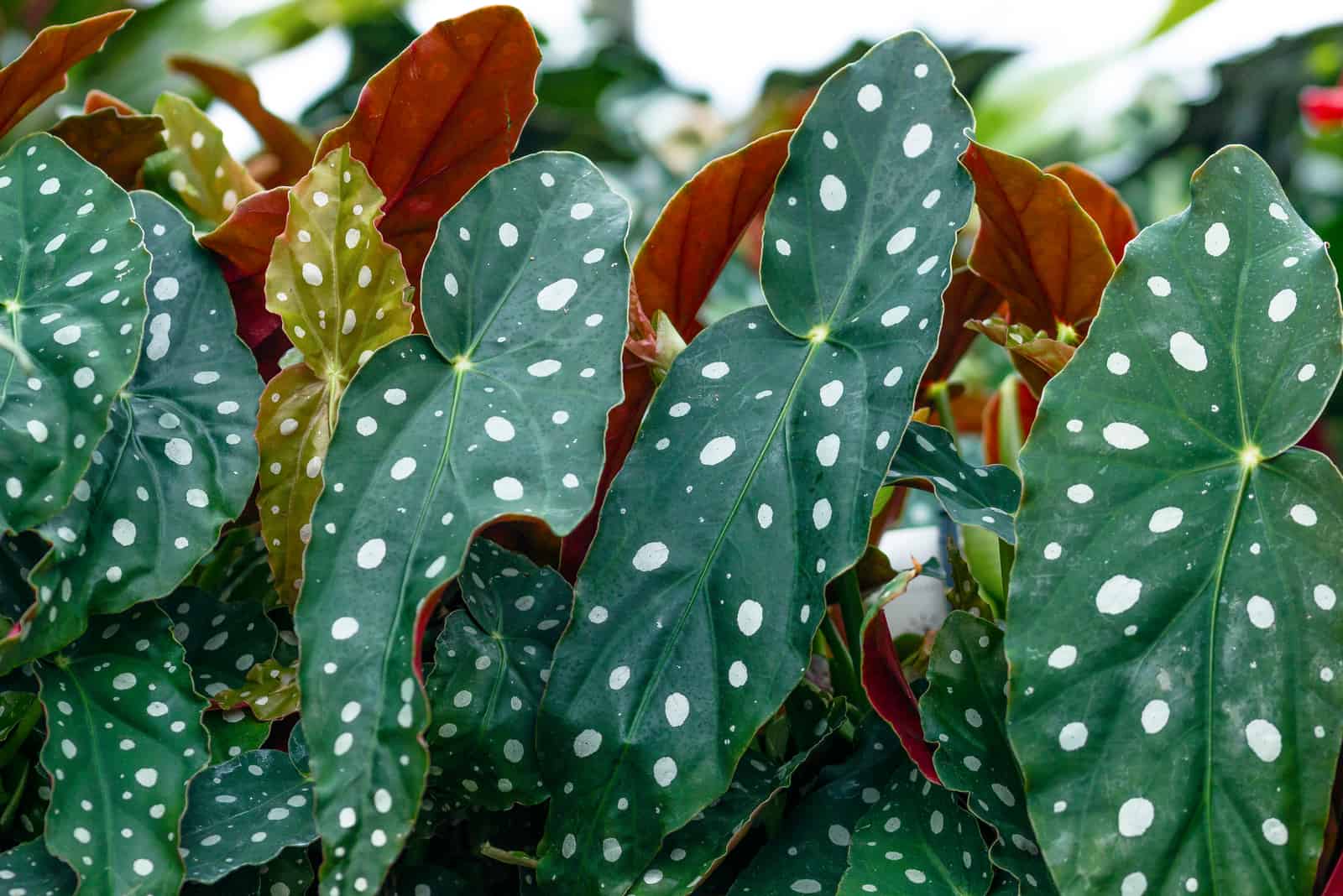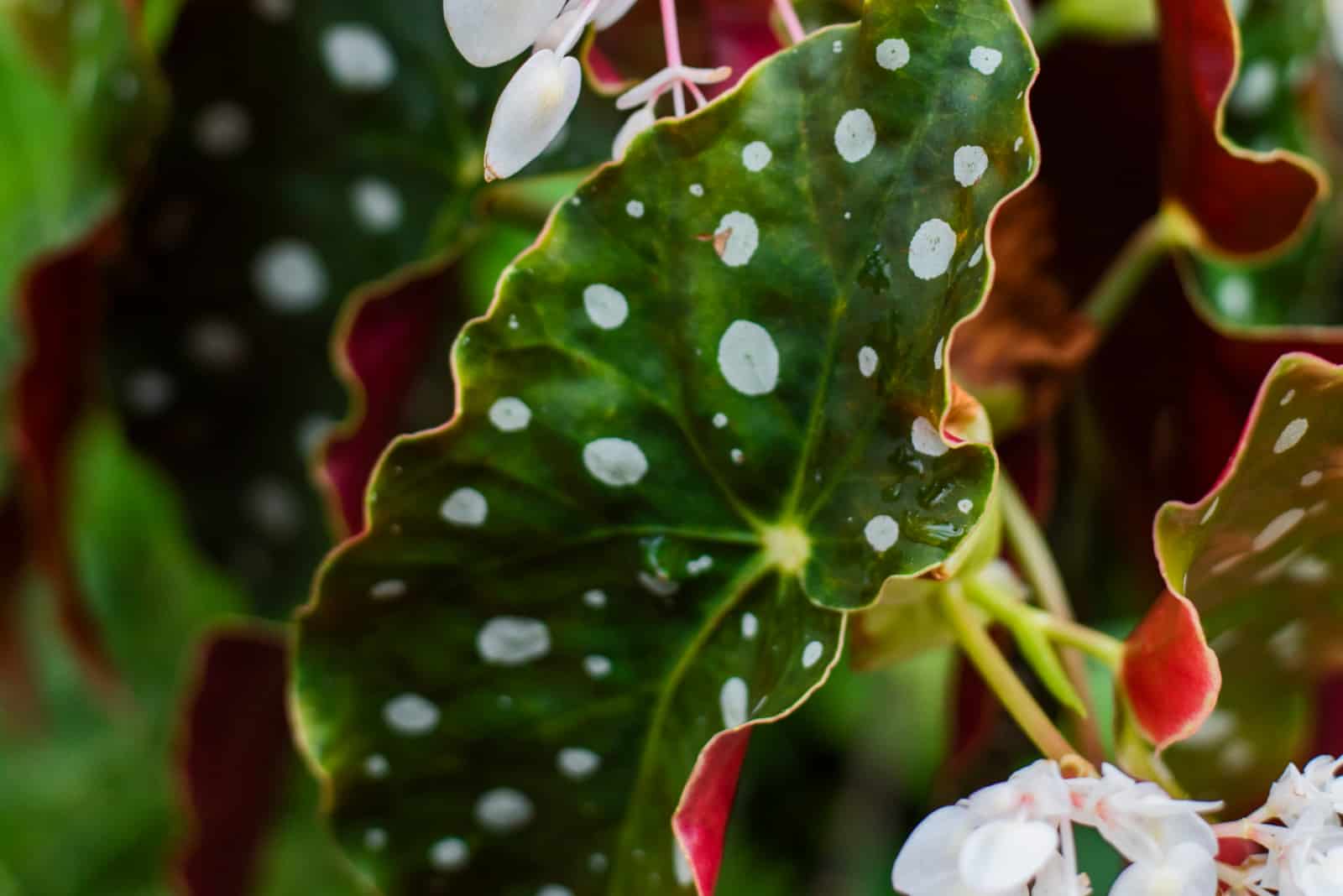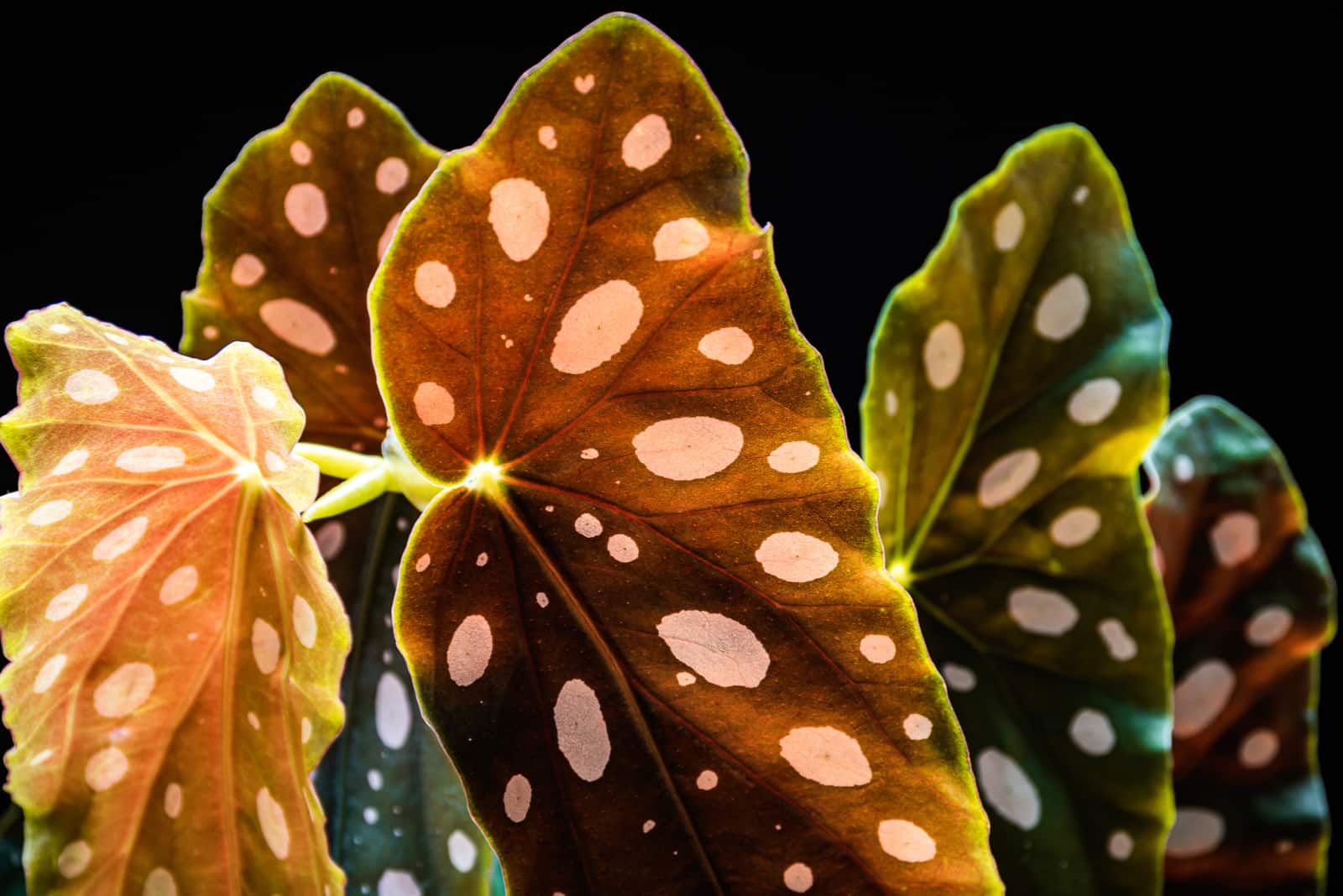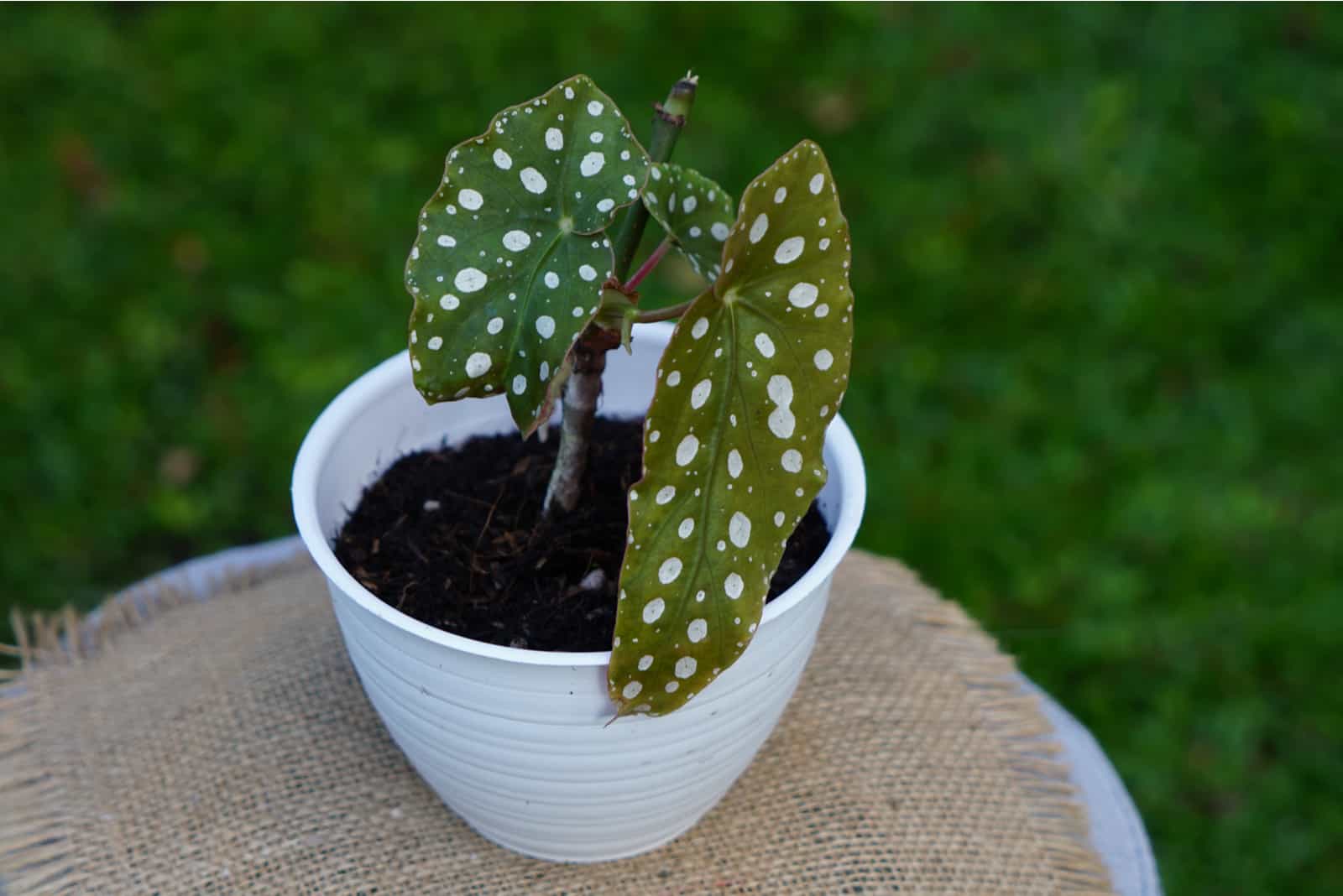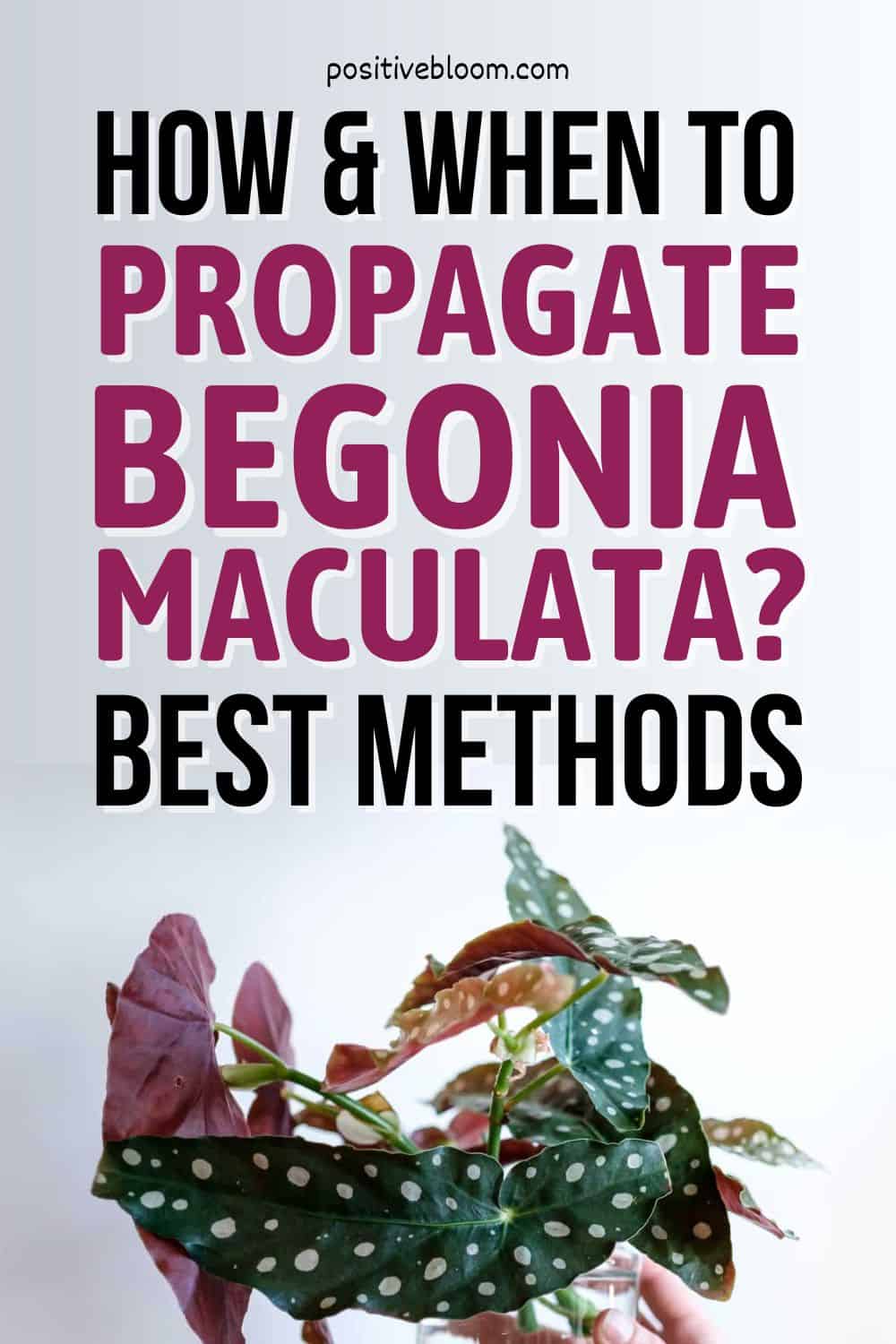Begonia maculata or polka dot begonia definitely stands out from the other plants in the Begonia genus.
If there was an award for the most stylish leaves of plants, the begonia maculata would undoubtedly get the prize; the silver dots and red undersides of its angel wings-shaped leaves can’t go unnoticed.
No wonder so many ask if it’s possible to propagate Begonia Maculata. Luckily, it’s possible, and you are in the right place to learn how.
Therefore, let’s see how to propagate Begonia Maculata!
When To Propagate Begonia Maculata?
It isn’t only essential to know how to propagate houseplants, but the time that you do so also matters.
Before you learn the procedure, you have to be informed about when to start propagating and what to expect.
There are four methods you can use to get a new begonia maculata wightii: leaf cuttings, stem cuttings, from seeds, and division.
If you decide to create a new polka dot begonia from seeds, sow the seeds in the early spring.
You can propagate begonia maculata plants from cuttings at any time. Still, the optimal time to establish a healthy plant is in the spring or summer.
Your polka dot plant will perish once the first frost arrives if you don’t imitate a tropical environment. If your plant is dying outdoors, stem cutting is an excellent approach to bring the plant back to life indoors.
How To Propagate Begonia Maculata
I’m sure you’ll be thrilled when I say it’s easy to propagate this plant. You can choose between four methods, and each has an excellent success rate.
I’ll show you the process of getting a baby polka dot, step-by-step. Make sure not to miss anything!
Let’s start!
By Leaf Cuttings
Here are seven steps to propagate by leaf cuttings.
1. Find a few fresh leaves on your begonia maculata and snip them off.
2. If you want to get a lot of new polka dot begonias, you can turn the leaves upside down and slice them using a sharp and sterilized knife. You can also use a razor blade but be particularly cautious. Always sterilize it with bleach or 70% isopropyl alcohol, no matter which tool you use.
On the other hand, there’s actually no need to slice the leaves if you plan to gain only a few baby polka dots. Simply cut a few leaves from the mother plant; make sure each leaf has a petiole (about an inch of the petiole is enough).
3. It’s time to make a nursery for the leaf cuttings. You’ll need a small pot and a well-draining potting mix, and the mix can consist of perlite, vermiculite, or peat moss. Fill the pot with the mixture.
4. Insert the leaf wedges or polka dot begonia’s petiole stalks into the soil, wrap the nursery pot with a plastic bag, and put it in bright, indirect light. Please don’t leave the container exposed to direct sunlight as the propagation won’t work.
5. Keep the cutting moist but make sure the soil isn’t overwatered as this could cause root rot.
6. You can expect the roots of the new begonia maculata to sprout in three to five weeks.
7. Six weeks after the roots have sprouted, your begonia maculata is ready for transplanting.
By Stem Cuttings
Before moving on to the next procedure, I have to mention that you can propagate the plant by stem cuttings in soil or in water.
If you decide to use stem cuttings to propagate this begonia plant, first, you should know how to take the cuttings.
Take a cutting of your plant with a pair of clean (sterilised with bleach or alcohol), sharp scissors, or use the cuttings you’ve clipped off if you’ve been trimming. The begonia cutting should have at least one node attached (the more, the better) and at least one leaf. Fortunately, it doesn’t matter where you make the cut.
The cutting should be right below the node when it comes to other indoor plants. That’s not the case with a begonia maculata, as the new roots will cluster around the nodes anyway. Additionally, the roots can grow all over the stem.
Now you can choose where to place the cuttings. You have two options: soil or water.
Stem Cuttings In Soil
1. Fill a container with a potting mix (perlite, vermiculite, or peat moss).
2. Moisten the potting mix.
3. Put the nursery pot in a warm place with bright, indirect light. The roots will develop in a couple of weeks, so keep the soil moist (not wet) during this time. If you are unsure about the light, consider investing in grow lights.
4. To help enhance beneficial humidity levels, you can use a humidifier or place a clear plastic bag over the cutting. Make sure to uncover the plant once or twice a day to allow the air to circulate.
5. New roots should be well grown after a couple of weeks. You can check this by gently tugging on the stem to see if there is any resistance.
Here’s a video on how to propagate this begonia in soil:
6. After the root system is developed, continue with the usual care.
Stem Cuttings In Water
1. Fill your container halfway with temperate water (to avoid shocking your delicate cuttings) and lay your cuttings in it so that the water covers the bottom third.
If more of the cutting is immersed in the water, the risk of it rotting increases. If you notice the leaves are in contact with the water, remove them now, as they will begin to rot after a few days underwater.
When propagating, I suggest you use a clear container, since it allows you to see everything more clearly.
2. Place the glass in a bright yet shady area. Direct light will harm the cutting and prevent it from propagating successfully. A light monitor can determine whether the begonia maculata’s cuttings are receiving enough light.
You can also use grow lights to promote growth.
You can apply a rooting hormone at this point (if you want to) to promote new growth. The fresh cutting’s root growth will be accelerated if you decide to use the rooting hormone.
3. Refreshing the water is one of the essential procedures in the begonia maculata’s multiplication process (every two to three days will work well). This kills harmful bacteria in the water and prevents it from standing. It’s preferable to avoid standing water because it will begin to smell and is almost always an indicator that something’s wrong.
Fortunately, begonia maculata wightii cuttings grow roots quickly. After only a few days, you should see two delicate roots emerge from the node.
However, this can depend on many factors, so some cuttings will grow much faster than others. All in all, when compared to some other common indoor plants, where you may have to wait months for anything to develop, this process is much faster.
This is my favorite feature, as no other plant can develop roots so quickly.
Propagation From A Polka Dot Begonia’s Seeds
Growing the polka dot begonia from seed is complex and time-consuming.
You won’t get young begonias that are exact replicas of their parents if the seeds are from hybrid plants.
This is due to the fact that begonia hybrids are a combination of several varieties. If you utilize sterile hybrids, you might not even receive any baby plants.
When collecting seeds, only clip the stems after the plant has finished blooming. Cutting branches that still have blooms on them is not a good idea. But, it’s a good idea to save begonia maculata seeds once the flowers have started to dry.
By Division
Here’re the steps to get a new begonia maculata by division.
1. Remove your polka dot plant from its container.
2. You must separate the different offshoots/stems in order to propagate your polka dot begonia using the division method. These plants are very easy to separate when compared to other plants.
Carefully remove the begonia from its container. Don’t pull too hard on the leaves because they’re delicate, but carefully wriggle the plant out of the pot.
3. Pull the various parts of the begonia maculata apart. It’s sometimes challenging to do this, and you may need to untangle the odd root.
4. Now, you should examine the roots carefully. If you notice any discolored or mushy polka dot begonia roots, you’ll have to remove them as they might be contagious.
It’s entirely up to you how many new plants you want to grow. When separating parts of the plant, always use shears instead of tugging the plant apart, as this can easily destroy it!
5. Place the mother begonia into its original pot.
6. Place each baby plant into a fresh potting mix; never reuse the old potting mix (of any other plant) as it might be contagious and cause severe damage to your new begonias.
Stick to the usual begonia maculata plant care.
Why Propagate Begonia Maculata?
Many beginner growers ask why propagating is beneficial or why they should do it in the first place?
You’ll get the answer to this question if you visit an online store and search for a plant to purchase. Some plants aren’t affordable; honestly, why not propagate if you already have a healthy and beautiful plant?
Therefore, propagating houseplants is the cheapest, yet the most exciting, method of getting new plants.
If your begonia maculata has started to die due to overwatering (which is unfortunately simple to do), overfertilization, or mistreatment, the best way to save it is to take the healthy stems and multiply them to develop new healthy plants before it’s too late.
If you provide a begonia with the right conditions, you can expect it to overgrow the pot pretty quickly. So trimming it from time to time will control its growth, and propagating the stems you trimmed will prevent potential new plants from becoming waste.
Common Mistakes When Propagating
Honestly, we all make mistakes all the time, not only when propagating, don’t you think?
I know it can be disheartening to find out that multiplication didn’t succeed. That’s why I decided to give you some advice for you to understand what could possibly go wrong.
The Cutting Is Placed In Water For Too Long
Now that you know that the multiplication of begonia maculata is possible by stem cuttings in water, you should also know a couple of other things.
I mentioned that you should change the water regularly if you want to see new and healthy roots emerging.
How long does it take for a begonia cutting to rot when placed in water for too long? Unfortunately, the cutting will rot in just a few days.
As soon as you notice a mushy and soft cutting, it would be best if you searched for a healthy node. If you find any, your cutting still has a chance to recover.
Direct Light
It’s essential to put containers with cuttings in bright indirect light. If the nursery pot is exposed to direct sunlight, the new leaves will turn pale, even if it was for just a short period.
Never leave the container exposed to direct light but also keep it away from low light, as the roots need light to sprout.
Patience
Patience is the key to successful multiplication. As mentioned, the roots can take just a week to sprout, and if that’s not the case, it doesn’t mean something is wrong.
If you are unsure about the procedure’s outcome, check the conditions once again.
If everything is under control, like the potting mix, water, light, humidity, and temperature, I suggest you wait. It’s worth it!
Begonia Maculata Care Guide
Compared to other common indoor plants, begonia maculatas are almost easy to care for. When I say almost, I mean they are only fussy about light and soil.
They prefer bright indirect light and hate overwatered or underwatered soil.
Let’s see some care tips!
Light Requirements
If you grow plants like philodendrons, you may know that partial shade works best for tropical plants.
However, a begonia maculata prefers a bit more shade than other tropical plants.
If you want to see beautiful olive green leaves, place this begonia in indirect or filtered light.
Two devices can help you to ensure the right light conditions: a light meter and grow light.
If you want to take your plant outside in the summer, make sure it’s in the shade and out of direct sunlight.
If you decide to use a grow light, make sure it isn’t too near the plant and follow the instructions in the manual.
If your Begonia maculata’s leaves become burned, move it to a less sunny area of the room or, if you use grow lights, make sure they are further away from the plant.
Humidity Requirements
The Begonia maculata is native to Brazil, and that’s why it prefers high humidity levels of at least 50%.
Bathrooms with the correct amount of light, as well as a terrarium, are excellent choices. Alternatively, a humidifier can be used.
You can put this begonia in your favorite room, but be sure to arrange a saucer of water near it so that the water evaporates and generates the needed humidity.
Never submerge the pot in the water saucer, since this may cause the Begonia maculata roots to become too damp. Because Begonia plants are sensitive to powdery mildew, you should keep the leaves dry.
A humidifier is an excellent technique to enhance the humidity and ensure consistent high humidity levels for your plants.
Temperature Requirements
The ideal temperature for this begonia is between 67 and 70 degrees Fahrenheit.
Bear in mind that this is a tropical plant and won’t grow in colder climates.
Never let the temperature drop below 60 degrees Fahrenheit as your precious polka dot begonia might suffer from damage.
Soil
This begonia thrives in well-draining soil; I suggest you use a soil mix made of clay, sand, and loamy soil.
Root rot is a serious problem for this plant. So adding a layer of pebbles or broken terracotta pots to the bottom is a good idea if you want to enhance the drainage.
Watering
When it comes to watering this begonia plant, balance is key.
Never leave the soil to dry out between waterings. Also, avoid overwatering as it can cause permanent damage.
Before you start watering, put your finger in the soil to check the moisture.
If you are unsure about the watering, interestingly, it’s better to wait until the begonia maculata plant starts wilting than to go in the opposite direction.
I suggest you apply top watering but make sure the leaves stay dry.
Fertilizing
The plant’s fertilizing schedule is simple: water twice a month during the growing season (spring and summer) and every two months in fall and winter.
A balanced 17 17 17 liquid fertilizer is an excellent choice as it will promote the growth of new leaves.
I suggest that you dilute the fertilizer to half strength to avoid over-fertilization.
Repotting
This begonia is a fast grower, which means it needs repotting more often, precisely once a year during the first years of growth.
Interestingly, this begonia likes to be rootbound, so you should use smaller pots.
Never skip repotting, as your polka dot begonia won’t thrive and grow healthily.
Always repot at the beginning of the growing season (spring).
A new pot should be larger (not too large) and have drainage holes.
When repotting this begonia, always use fresh potting soil to avoid contamination.
Pruning
Many growers skip this part, but from my experience, pruning will help your begonia grow healthily and thrive.
Why prune? First, your begonia may get leggy, and pruning is a great way to revive it. Second, pruning discolored, dead, or diseased leaves will help the plant grow healthily.
You can prune your begonia in three ways:
1. Cut your begonia down to its base to promote the growth of the entire plant.
2. Remove branches to maintain the begonia’s shape.
3. Remove only the dead leaves and spent flowers.
Choose spring to prune your begonia in, as the plant is growing actively and pruning will serve as a boost.
Cleaning
I mentioned that you should apply top watering and keep the leaves dry. However, this doesn’t mean that water shouldn’t touch the leaves.
Take a soft sponge, dip it in water and rub the maculata’s leaves gently. Alternatively, fill a spray bottle with water and spray the leaves.
It’s essential to dry the leaves after cleaning, as excess water can cause the leaves to soften and rot.
Begonia Maculata Plant: Common Issues
The B.maculata is a houseplant and can be affected by diseases and pests. It’s not common, but it can still happen.
Luckily, we have a solution to each problem, so stay tuned.
Pests
Fortunately, pests aren’t inconceivable for this begonia. Mealybugs and whiteflies may pay a visit, but it’s relatively easy to get rid of them.
It’s essential to inspect your begonia regularly. If you spot brown lesions, your plant may be suffering from mealybugs or a whiteflies infestation—mix neem oil and dish soap to remove these annoying pests.
Powdery Mildew
Wet leaves cause powdery mildew, and if left untreated, this could cause severe damage.
To solve this problem, apply bottom watering.
However, if the problem is more serious, fungicide is the best treatment option.
Root Rot
Another consequence of overwatering is root rot. Soggy soil will attract pathogens, and you’ll notice mushy and discolored roots if root rot is the problem.
Remove the affected begonia roots, repot the plant and ensure good drainage.
Too Tall And Leggy Stems
If your begonia plant grows in low light, its stems can be too tall and leggy.
Check the light conditions and ensure bright indirect light if you notice these changes.
Brown And Crispy Leaf Edges
The cause of brown and crispy leaf tips and edges is underwatering.
Dry soil is an indicator of underwatering, so remove the affected begonia leaves and water the plant thoroughly.
Yellow Leaves
Overwatering is the culprit once again. Excess water will clog the air spaces within the soil and prevent the air circulation that the roots need to grow healthily.
The nutrients won’t come to the leaves, and as a result, the leaves will turn yellow.
Delay watering for some time and leave the soil to dry. In the meantime, check the soil moisture regularly.
Be careful, don’t leave your begonia exposed to direct sunlight to dry, hoping it will recover sooner; the effect will be the opposite and cause more damage.
Toxicity
Crystals of calcium oxalate are present in the begonia’s leaves. When ingested, the leaves release harmful crystals causing health issues.
The Begonia maculata is toxic to humans and pets.
Wrapping Up
Fascinating silver polka dots, olive-green leaves, and white flowers are definitely the main reasons to propagate begonia maculata.
Pay attention to when and how to propagate this eye catching plant.
Even if it may seem complicated, it isn’t. Don’t hesitate; getting a new begonia maculata has never been easier.
Until next time!
Like this post? Share or pin it for later!

